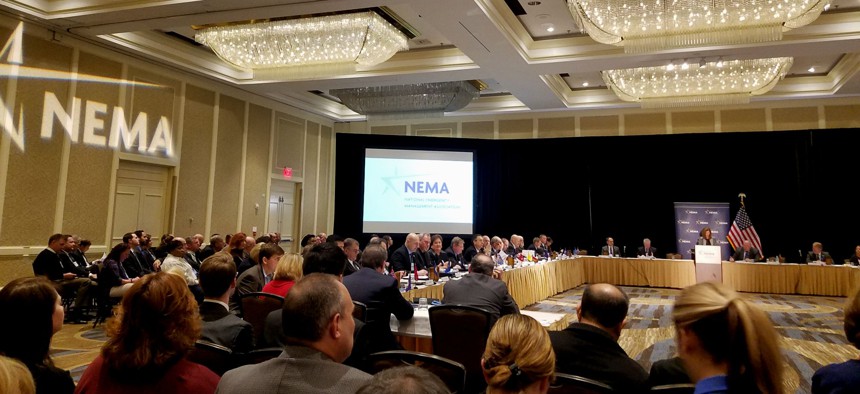Acting FEMA Chief Spotlights Agency’s Priorities for State and Local Emergency Managers

State and local emergency management professionals gathered in Alexandria, Virginia, for the National Emergency Management Association's mid-year forum on Thursday. Michael Grass / Route Fifty
President Trump “wants to make sure FEMA is responsive ... and make sure that we’re there for you.”
ALEXANDRIA, Va. — While President Trump’s administration has been dealing with plenty of its own various political crises since his inauguration, the White House has not yet had to deal with a major real-life emergency management situation.
While there have been tornadoes and flooding situations, the level of the response challenges don’t necessarily stack up to what will be required for, say, a repeat of the magnitude 7.3 Charleston, South Carolina, earthquake in 1886, or a major hurricane slamming into Houston.
Disaster response, however, isn’t directly managed from the White House. It’s handled by federal, state and local government professionals like those who gathered this past week the National Emergency Management Association’s mid-year forum just outside the nation’s capital.
On Thursday, the acting administrator of the Federal Emergency Management Agency, Robert Fenton, Jr., addressed NEMA’s general session, where representatives from the 50 states and territories and other state and local stakeholders had gathered.
Fenton, who has served as FEMA’s Region 9 administrator, told the crowd that he’s there to keep the agency running until the White House names a new leader for the agency.
“The way I look at my job is to keep the train on the tracks ... to keep what we’re doing,” Fenton said, telling the emergency management professionals that the change in administration is an opportunity to implement new policies that will help FEMA improve its response and coordination with its state and local partners.
“The new administration is there to listen,” he said, noting that FEMA’s new chief of staff, Eric Heighberger, is a veteran of the agency who served in various positions in the administration of then-President George W. Bush and worked for the House and Senate Homeland Security committees on Capitol Hill.
“We have a very responsive president,” Fenton said. “He wants to make sure FEMA is responsive. He wants to make sure we are effective in doing that … and make sure that we’re there for you.”
Fenton highlighted areas of policy priorities for FEMA.
Those include:
- Improving the way it delivers public assistance, the agency’s largest grant program.
- Getting Congress to reauthorize the National Flood Insurance Program. “It will be critical to keep that on pace,” Fenton said.
- And, improve the way the agency delivers post-disaster housing. “We really need to focus on our disaster housing program,” he said, making it “faster and more efficient.”
Following last year’s massive flooding in Louisiana, FEMA deployed more than 4,000 temporary housing units to victims of the disaster and “received a lot of feedback from stakeholders,” Fenton said.
Providing temporary housing remains a major challenge for the agency, depending on where a disaster strikes. If a flood impacts a rural area, for instance, there often aren't enough rental units available, he said. “How do we keep them within these areas? All those things are open to discussion.”
Considering the importance of FEMA’s responsibilities, Fenton delivered a relatively upbeat message. “I really love this agency. I love our mission. I love what we do with disasters … [and] helping Americans at their greatest moment of need.”
PREVIOUSLY on Route Fifty:
Michael Grass is Executive Editor of Government Executive’s Route Fifty and is based in Seattle.
NEXT STORY: On the Brink of AHCA Vote, Kansas Lawmakers Make Their Own Move on Medicaid






